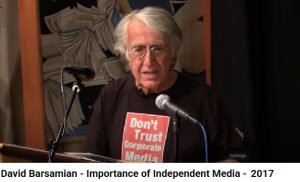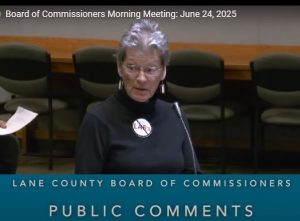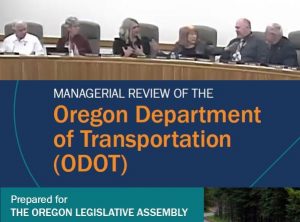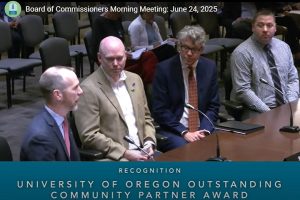City shares plans for sidewalks near Tugman Park
8 min read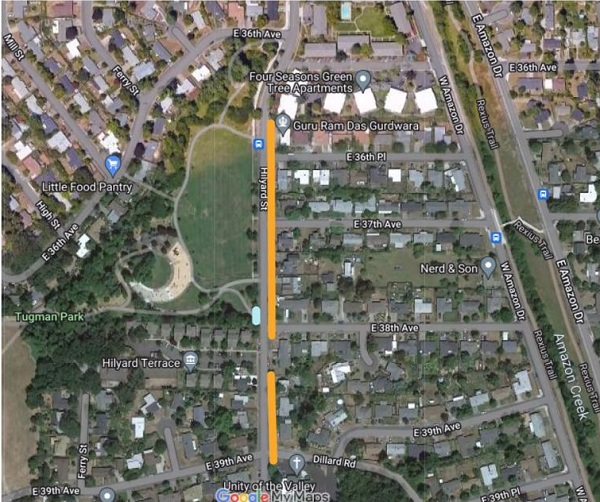
The City plans to start meeting with residents near Tugman Park. By completing the sidewalk on the east side of Hilyard and adding “bumpouts” for pedestrian crossings, they hope to make the street safer for people walking and biking.
[00:00:16] Reed Dunbar (Public Works Engineering): As I think most of you are aware, the City of Eugene does not have a sidewalk infill program. And so generally it is the burden of the property owner to update their properties with sidewalks. And as you can imagine, we try not to force people to do that and we look strategically for opportunities to provide sidewalk connections, where it is most important— that being near transit stops, near parks, near schools, and near places where people work or shop.
[00:00:43] And so one of the locations that came up was the Tugman Park area, because while there is a nice sidewalk that goes through the park, on the other side of Hilyard Street there is none.
[00:00:55] So starting basically on that north side of Dillard, all the way up to almost 38th—there is one lot there that has completed sidewalks—but then between 38th and just north of East 36 Place, there are no sidewalks.
[00:01:10] John Q: Reed and Catherine Rohan showed where the new sidewalks will be placed.
[00:01:14] Reed Dunbar: We tried very hard to avoid existing trees that are in people’s yards. If there are planters or shrubs—these sorts of things that folks care for and plant—we try to avoid those as well. But our city standard for sidewalks would be to have a setback sidewalk. So not one that’s curbside.
[00:01:32] And that allows people walking to have a little bit more space between moving traffic and walking traffic is generally thought to be more pleasant. The space next to the curb is generally also where a lot of trees live. And so it gives us space for street trees in the future. So sidewalks generally go behind that.
[00:01:50] And as we go through that, I think you’ll notice that we were opportunistic about where the sidewalks were located so that we did not disturb existing plants.
[00:02:00] John Q: Reed said the City will be improving neighbors’ driveways.
[00:02:03] Reed Dunbar: As part of the sidewalk install, to make sure that people still have access to their driveways, we’ll rebuild the driveway aprons— the part that touches the street— and then get that up to grade so that the sidewalk is then flat again. So, it’s not just sidewalks, it’s also driveways and making sure that they mesh well with the sidewalks that we’re constructing, so that they’re all at the same level.
[00:02:27] Jess Roshak (Southeast Neighbors Transportation Chair): So with a five foot sidewalk and between sidewalk and curb maybe—
[00:02:32] Reed Dunbar: That’s generally around five or six.
[00:02:34] Jess Roshak: So that’s 10 feet. I mean, their whole front yard is basically just going to be a sidewalk. That’s going to be maybe a hard sell for those property owners. I’m just wondering if there’s any consideration about how far that’s going towards their front door.
[00:02:49] Linda Duggan (Southeast Neighbors Transportation): In those cases where it’s close to the people’s doors, could that be closer then to the curb? I know you want to have a space between the curb and the sidewalk, but in those cases, could it go closer to the curb?
[00:03:03] Reed Dunbar: Sure. Yeah. I mean, these are the conversations I expect to have with those properties. I will say again that we don’t have a sidewalk infill program currently. And so what we’re offering to do here is to pay for these sidewalks free of charge. And so, this is a benefit because we could go back in and ask for these sidewalks to be installed. And so, we’re trying to do the best we can to preserve the existing trees, shrubbery, plant life, and yet maintain some yard space. But we designed this based on not only where existing objects were, but also to make sure that we have proper drainage of all the sidewalks.
[00:03:42] Dennis Hebert (Southeast Neighbors chair): From what I understand, it’s public right of way so many feet from the center of the street to where you are having the sidewalk. The property that you’re putting the sidewalk on is not the person’s property. It is a city public right of way.
[00:03:59] Reed Dunbar: You are correct. But most folks view that as their yard and I think rightfully so, because they’ve been maintaining it. (All these years.). So the balance is to try to give them a sidewalk and yet allow them the space that does feel very much like personal space because it has been for so long. So if we need to make adjustments, we’ll see if we’re capable of doing that. We’ll find out during that investigation process with folks, if that’s something we need to look into,
[00:04:27] John Q: Reed said to protect trees, the final location of the sidewalks may change.
[00:04:32] Reed Dunbar: So as we’re tearing up the ground there, we will go ahead and peek at those trees and make sure that the roots are happy and that we’re not going to disturb them with the sidewalk project and our city foresters—who are tree people, they’re foresters—come out and inspect that and won’t let us disturb it.
[00:04:48] And so we may make field adjustments. For example, if that tree, if they needed more root zone, we could potentially move that sidewalk up a little bit. and just gave her a little bit more room to breathe, but that would be a field determination based on whatever the roots are doing, which at this point we just don’t know.
[00:05:05] John Q: The project also involves creating safe pedestrian crossings.
[00:05:10] Reed Dunbar: Those curb extension slash bump-outs? When we bump out a corner at an intersection, number one is, it narrows the street a little bit. And so it shortens the crossing distance for people who are trying to get across the street. The second thing is that if there is no one parked on the street at the time it also makes the edges a little bit narrower and it tends to slow people down. So it’s a form of passive traffic calming.
[00:05:34] John Q: The extra space also provides for a more gentle wheelchair ramp.
[00:05:38] Reed Dunbar: It also allows our designers to get the ADA grades a little bit better because it gives them more room to be able to drop the sidewalk down, and more room once you get to the top of the ramp to get it back straight so that it matches up with the rest of the sidewalk. So these give us a lot of benefits and it’s a standard feature in the city of Eugene to do these curb extensions whenever we’re doing a roadway project or sidewalk project.
[00:06:00] John Q: One Southeast Neighbor expressed concern about the bumpouts.
[00:06:05] Jess Roshak: My experience with the bump-outs on East and West Amazon in my neighborhood are that it juts you out farther into the oncoming lane of traffic. And seeing as how there’s not a whole lot of leeway there and cars are going very fast, I’ve seen actually a collision for that reason. So I do want to bring that up, that turning out around a bumpout into a busy road, especially for a bigger vehicle, like if you’re driving a truck or a trailer, is extremely concerning.
[00:06:35] Reed Dunbar: A lot of our streets were designed in the (19)50s and (19)60s based on the highway capacity manual, and they are as wide as they are because we said, ‘Let’s make everything wider.’ The result of that is 40,000 deaths a year because people are driving too fast.
[00:06:51] And so what we’re trying to do with our Complete Streets initiative and our Vision Zero effort is to narrow things up so that our most vulnerable users— people on sidewalks, people on bikes— have protected spaces to be, and people in cars have to slow down. If you go around one of those curb extensions at 15 miles an hour, it works fine.
[00:07:11] John Q: One Southeast Neighbor was concerned that the crosswalks will not be marked immediately.
[00:07:16] Linda Duggan: We have lots of kids that use that park and go across the street and, I’m sort of concerned that we wait until something’s happened or not working before we are proactive and have a crosswalk there. I think the flashing crosswalks do get people’s attention even more so for safety reasons.
[00:07:42] Reed Dunbar: Yeah. I understand that one of our giant limitations is the cost of those flashing lights, which is about a hundred thousand dollars. And so that’s why we have to sort of do this step-by-step: We don’t have enough money to do everything at once. And so we try an intervention we think will work, and if it doesn’t, we move on to the next thing.
[00:08:00] We think once we traffic calm the street that a standard crosswalk will probably work. The next step would be if folks still aren’t yielding, we’re not getting good yielding behavior at the crosswalk, that next step would be adding the flashing lights. We do have examples of where we’ve gone back to crosswalks and retrofitted them for more interventions, like those flashing lights.
[00:08:22] John Q: The City has also gone back and changed its approach to traffic calming. Reed Dunbar.
[00:08:27] Reed Dunbar: There’s two theories in traffic calming. One of them is called horizontal deflection and then the other one is vertical deflection. Those are the humps where it feels like something’s going to happen to your car. It takes the fear of damage for folks to comply.
[00:08:40] We don’t do horizontal deflection anymore, like what is on (East) 33rd. The devices that were spec’ed for there’s like these little humps, these little yellow round things, which at the time were called ‘turtle shells,’ did not end up being what we thought they were going to be. And so that design doesn’t work because of the horizontal deflection, and because the turtle shells that were supposed to entice folks into this serpentine pattern, is ineffective.
[00:09:10] John Q: City staff plan to start meeting with property owners along Hilyard in the next few weeks.
